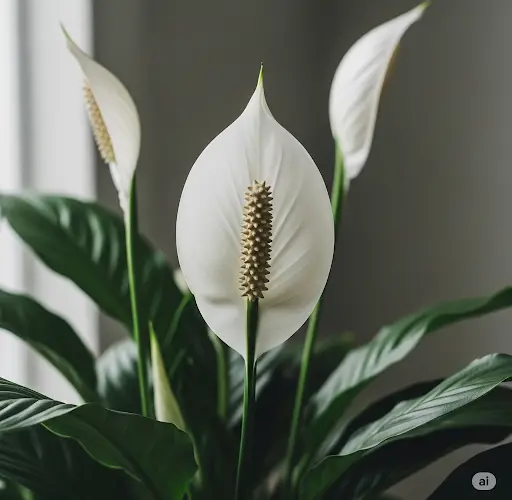Spathiphyllum, often referred to as “Women’s Happiness” or peace lily, is a beloved indoor plant known for its elegant white blooms and lush, dark green foliage. Though generally easy to care for, this plant can sometimes become reluctant to flower, especially when grown indoors under less-than-ideal conditions. The good news is that one tablespoon of a simple homemade solution can encourage abundant blooming and revitalize the plant’s appearance in a matter of days.
This technique is not only easy and cost-effective but also safe and natural. It improves nutrient availability, strengthens the root system, and helps trigger flowering by creating optimal conditions for the plant’s development.
Why Spathiphyllum Stops Blooming
If your peace lily hasn’t bloomed in months, or its leaves are starting to droop or yellow, you’re not alone. Common causes of flowering failure include:
-
Insufficient light (especially in dim indoor settings)
-
Poor or depleted soil
-
Overwatering or root rot
-
Lack of essential nutrients, especially phosphorus and potassium
-
A stressful environment (dry air, cold drafts, or compacted roots)
While Spathiphyllum can survive under suboptimal conditions, it only blooms when it’s truly thriving. That’s where this one-tablespoon solution becomes a game-changer.
The One-Tablespoon Bloom Booster
The formula is based on ingredients that are likely already in your kitchen. It provides essential nutrients and encourages microbial activity in the soil, which in turn helps the plant absorb minerals more efficiently.
Ingredients:
-
1 tablespoon of castor oil
-
1 liter of lukewarm, non-chlorinated water
Castor oil is rich in ricinoleic acid and essential fatty acids that support strong root systems and stimulate hormonal processes related to flowering. It also contains small amounts of nitrogen and minerals that help maintain healthy foliage.
How to Prepare the Solution
-
Add one tablespoon of castor oil to a liter of lukewarm water.
-
Shake or stir the mixture thoroughly to create a light emulsion.
-
Let it rest for 15–20 minutes to allow the oil to disperse more evenly.
Note: Since oil and water don’t mix easily, shake or stir just before applying to avoid uneven distribution.
How to Apply It to Spathiphyllum
-
When: Apply once every 3–4 weeks during the active growing season (spring through early fall). Avoid applying in winter when the plant is semi-dormant.
-
How much: Use 100–150 ml of the mixture per plant, poured directly onto moist soil.
-
Where: Apply at the base of the plant, avoiding the leaves and stem.
-
Precaution: Always water the plant lightly before applying the mixture to prevent oil from damaging dry roots.
What to Expect After Application
Within 7–10 days of applying the solution, you may notice:
-
Firmer, glossier green leaves
-
New flower stalks beginning to form
-
A more upright and vibrant posture
-
A gradual increase in blooming frequency and longevity
Even peace lilies that haven’t bloomed in a long time often respond positively, provided other care elements like light and watering are on point.
Tips to Maximize Blooming
In addition to using the castor oil mixture, follow these general care tips to keep your Spathiphyllum healthy and flowering:
-
Light: Peace lilies prefer bright, indirect sunlight. Too much direct sun can scorch the leaves; too little light will inhibit blooming.
-
Humidity: These plants thrive in higher humidity. Mist regularly or place near a humidifier or pebble tray.
-
Soil: Use loose, well-draining soil. Avoid compacted or waterlogged conditions.
-
Repotting: If roots are visible above the soil or the plant hasn’t been repotted in two years, consider upgrading to a slightly larger pot.
-
Cleaning: Dust leaves with a damp cloth once a month to improve photosynthesis and keep them looking vibrant.
-
Temperature: Keep indoor temperatures between 18–26°C (65–79°F). Avoid drafts and sudden temperature changes.
Works on Other Houseplants Too
While this treatment is tailored for Spathiphyllum, it can also benefit other houseplants that are flowering or root-sensitive, such as:
-
Anthuriums
-
African violets
-
Cyclamen
-
Miniature roses
-
Orchids (in moderation)
Just adjust the dosage based on plant size and watering frequency.
Final Thoughts
A single tablespoon of this natural formula can make all the difference in your peace lily’s growth and blooming behavior. With consistent care and proper nutrition, Spathiphyllum can reward you with lush greenery and its iconic white flowers—symbols of peace, purity, and happiness.
So if your “Women’s Happiness” plant looks tired or flowerless, try this gentle boost. You’ll likely be surprised at how quickly it responds, bringing renewed life and beauty to your indoor garden.



